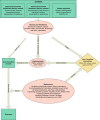How Do Care Transitions Work?: Unraveling the Working Mechanisms of Care Transition Interventions
- PMID: 34228021
- PMCID: PMC8263132
- DOI: 10.1097/MLR.0000000000001581
How Do Care Transitions Work?: Unraveling the Working Mechanisms of Care Transition Interventions
Abstract
Background: Failure of safe care transitions after hospital discharge results in unnecessary worsening of symptoms, extended period of illness or readmission to the hospital.
Objective: The objective of this study was to add to the understanding of the working of care transition interventions between hospital and home through unraveling the contextual elements and mechanisms that may have played a role in the success of these interventions, and by developing a conceptual model of how these components relate to each other.
Research design: This was a qualitative study using in-person, semi-structured interviews, based on realist evaluation methods.
Subjects: A total of 26 researchers, designers, administrators, and/or practitioners of both current "leading" care transitions interventions and of less successful care transition intervention studies or practices.
Measures: The contextual elements and working mechanisms of the different care transition intervention studies or practices.
Results: Three main contextual factors (internal environment, external environment, and patient population) and 7 working mechanisms (simplifiying, verifiying, connecting, translating, coaching, monitoring, and anticipating) were found to be relevant to the outcome of care transition interventions. Context, Intervention, Mechanism, and Outcome (CIMO) configurations revealed that, in response to these contextual factors, care transition interventions triggered one or several of the mechanisms, in turn generating outcomes, including a safer care transition.
Conclusion: We developed a conceptual model which explains the working of care transition interventions within different contexts, and believe it can help support future successful implementation of care transition interventions.
Copyright © 2021 The Author(s). Published by Wolters Kluwer Health, Inc.
Conflict of interest statement
The authors declare no conflict of interest.
Figures

References
-
- Williams TA, Leslie GD, Elliott N, et al. Introduction of discharge plan to reduce adverse events within 72 hours of discharge from the ICU. J Nurs Care Qual. 2010;25:73–79. - PubMed
-
- Kripalani S, LeFevre F, Phillips CO, et al. Deficits in communication and information transfer between hospital-based and primary care physicians—implications for patient safety and continuity of care. JAMA. 2007;297:831–841. - PubMed
-
- Coleman EA, Berenson RA. Lost in transition: challenges and opportunities for improving the quality of transitional care. Ann Intern Med. 2004;141:533–535. - PubMed
Publication types
MeSH terms
LinkOut - more resources
Full Text Sources

